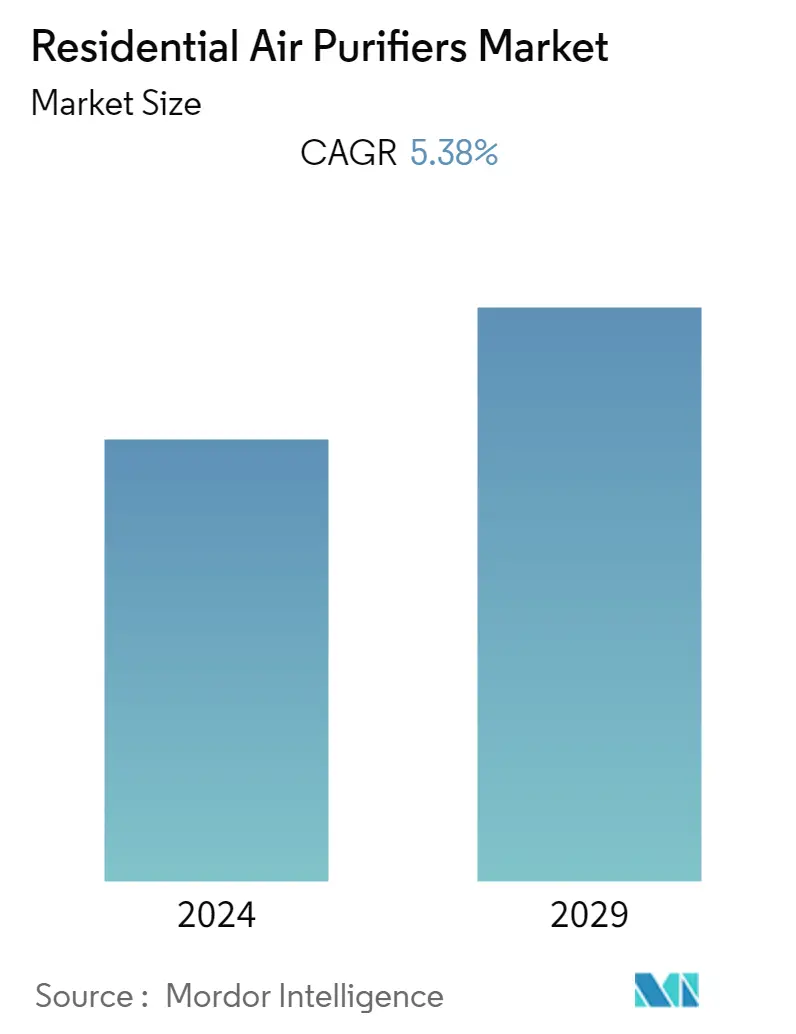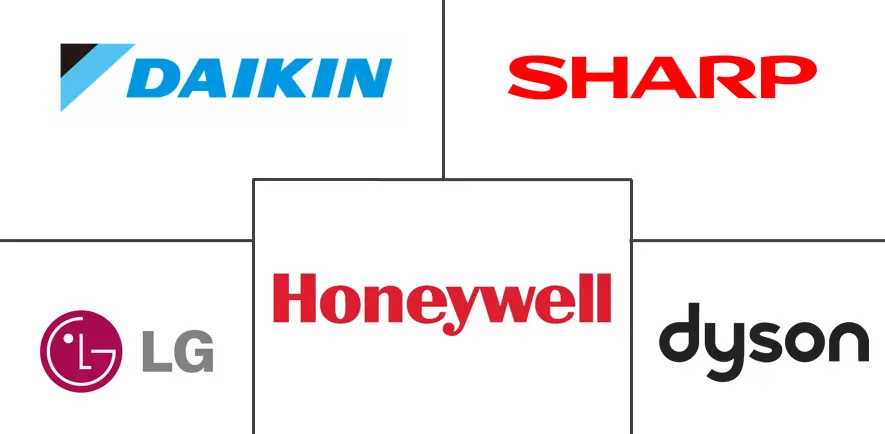| Study Period | 2020 - 2029 |
| Base Year For Estimation | 2023 |
| Forecast Data Period | 2024 - 2029 |
| CAGR | 5.38 % |
| Fastest Growing Market | Asia Pacific |
| Largest Market | Asia Pacific |
| Market Concentration | Low |
Major Players*Disclaimer: Major Players sorted in no particular order |
Residential Air Purifiers Market Analysis
The residential air purifier market is expected to register a CAGR of approximately 5.38 % during the forecast period of 2022 - 2027, reaching a market size of USD 5.36 billion in 2027 from USD 3.71 billion in 2020. The outbreak of COVID-19 increased the popularity of air purifiers significantly, as air purifiers and HVAC filters are designed to filter pollutants or contaminants out of the air that passes through them. Due to the COVID-19 pandemic, stand-alone air purifiers are adopted by consumers for clean and virus-free air, which is likely to boost the global air purifier market. With increasing sales of air purifiers, companies are launching new products. For instance, in July 2020, VironAire announced two affordable HEPA technology-based hospitals medical-grade air cleaners for hospitals, businesses, and homes. The residential air purifiers market is being driven by the high pollution levels, particularly in industrial countries in the Asia-Pacific region, and the increasing awareness about health issues associated with air pollution. With the growing population in urban areas where air pollution is more intense, air purifiers are likely to grow. However, in the countries where the air purifiers' standards do not exist, the consumers who opt for ineffective non-standard air purifiers feel cheated, making the air purifiers unpopular in those countries, thus, restraining the market.
- The high-efficiency particulate air (HEPA) filtration technology dominated the market in 2021, owing to its effectiveness in removing particulate matter. Also, the technology is becoming more readily available for use in home central air systems.
- With increasing pollution and deteriorating Air Quality Index in many countries, like India, China, and others, governments and organizations, like WHO, are formulating policies and steps to create significant market opportunities.
- Asia-Pacific dominated the market in 2021, with the most demand from countries like China, India, Japan, and South Korea.
Residential Air Purifiers Industry Segmentation
The residential air purifier market report includes:
| High-efficiency Particulate Air (HEPA) |
| Other Technologies (Electrostatic Precipitators (ESPs), Ionizers, and Ozone Generators) |
| Stand-alone |
| In-duct |
| North America |
| Europe |
| Asia-Pacific |
| South America |
| Middle-East and Africa |
Residential Air Purifiers Market Size Summary
The residential air purifier market is experiencing significant growth, driven by increasing pollution levels and heightened awareness of air quality issues, particularly in industrialized regions like Asia-Pacific. The COVID-19 pandemic has further accelerated the adoption of air purifiers as consumers seek to ensure clean and virus-free air in their homes. The market is characterized by the dominance of high-efficiency particulate air (HEPA) filtration technology, which is favored for its effectiveness in removing particulate matter. This technology's widespread availability and efficiency in capturing airborne pollutants have made it a preferred choice among consumers, contributing to its substantial market share. Despite the challenges posed by the lack of comprehensive standards in some countries, the demand for HEPA-based air purifiers is expected to remain strong, supported by ongoing innovations and product launches by key industry players.
Asia-Pacific holds a leading position in the residential air purifier market, with China, India, Japan, and South Korea being significant contributors to demand. Rapid urbanization and industrialization in these regions have led to deteriorating air quality, prompting governments to implement policies that create opportunities for market expansion. In China, for instance, stringent anti-pollution measures have spurred increased installations of air purifiers in various settings. However, the market faces challenges in countries with inadequate standards, where low-quality, non-standard products can undermine consumer confidence. Despite these obstacles, the market is poised for growth, driven by the introduction of innovative products and the efforts of major companies like Daikin Industries, Sharp Corporation, Honeywell International, LG Electronics, and Dyson.
Residential Air Purifiers Market Size - Table of Contents
1. MARKET SEGMENTATION
-
1.1 Filtration Technology
- 1.1.1 High-efficiency Particulate Air (HEPA)
- 1.1.2 Other Technologies (Electrostatic Precipitators (ESPs), Ionizers, and Ozone Generators)
-
1.2 Type
- 1.2.1 Stand-alone
- 1.2.2 In-duct
-
1.3 Geography
- 1.3.1 North America
- 1.3.2 Europe
- 1.3.3 Asia-Pacific
- 1.3.4 South America
- 1.3.5 Middle-East and Africa
Residential Air Purifiers Market Research FAQs
What is the current Residential Air Purifiers Market size?
The Residential Air Purifiers Market is projected to register a CAGR of 5.38% during the forecast period (2025-2030)
Who are the key players in Residential Air Purifiers Market?
Daikin Industries Ltd, LG Electronics Inc, Dyson Ltd, Honeywell International Inc and Sharp Corporation are the major companies operating in the Residential Air Purifiers Market.




